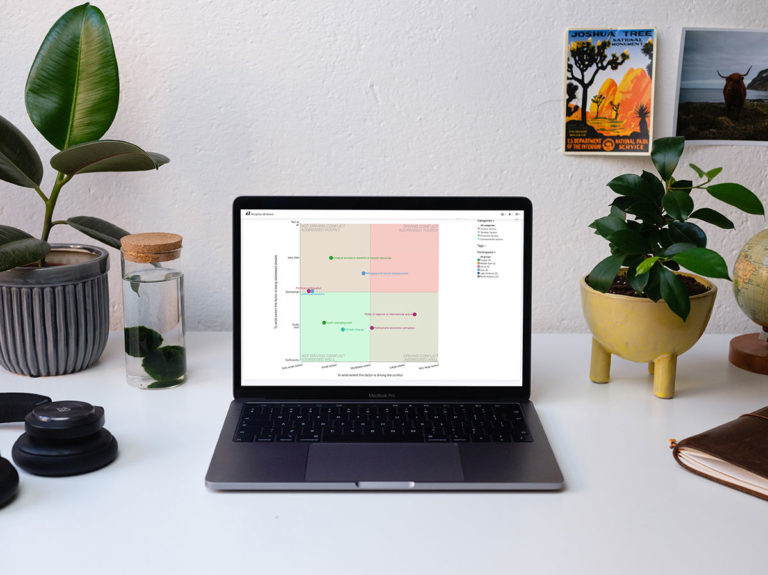“Use soft words and hard arguments” is an English proverb often cited by mediators that work to bring together different viewpoints of different people and reach a solution that all stakeholders can commit to.
Collaborative risk management is not much different from a mediator’s work, essentially. The ‘hard arguments’ for various risks need to be backed by hard data, while ‘soft words’ come in handy when people’s engagement is the aim. Good processes and easy-to-use software tools in risk management are helpful in achieving both:
- Gathering more and better data: Obtain the hard facts related to risks from all relevant stakeholders.
- Involving people: Bring together the hard facts to picture a successful outcome that all stakeholders can envision and commit to.
On our video, CEO and Co-Founder Mikaeli Langinvainio discusses the merits of collaboration in risk management from both perspectives: Improving the quality of data, and engaging people while doing so.
Spoiler: The facts-based and people-oriented sides of risk management do not happen in isolated silos but actually support each other for the most successful outcomes, particularly in risk management.
Collaboration between stakeholders is important for two reasons above others
As explained by Mikaeli Langinvainio on the above video, there are two reasons above others why collaborative risk management processes make a lot of sense.
1. Commitment and ownership of risks by stakeholders
In risk management, collaboration plays a crucial role in ensuring that stakeholders are committed to and take ownership of the risks associated with the organization.
When stakeholders actively participate in risk management processes, they develop a deeper understanding of the potential risks and their potential impact on the organization’s objectives.
This understanding fosters a sense of responsibility and ownership among the stakeholders, leading to increased commitment to addressing and mitigating those risks.
2. Improved reliability of risk assessments
Collaboration in risk management also enhances the reliability of risk assessments. It is unrealistic to expect that a single person, or even a group of persons such as the executive committee, can possess all the necessary knowledge and expertise to comprehensively assess all project risks.
Risks can emerge from various sources, such as technical, operational, financial, or regulatory factors. Each stakeholder brings unique insights and specialized knowledge related to their respective areas of expertise.
Time consumption, the number one challenge in risk management
Discussing the typical challenges related to risk management, Mikaeli Langinvainio raises the required time consumption from stakeholders as the most important challenge. Especially when there are multiple people involved in the project.
As the number of stakeholders increases, managing risks becomes more complex and time-consuming. What are the typical ‘energy drains’?
- Coordination and communication: In a complex operating environment with numerous stakeholders, each person may have their own perspective on risks and their potential impacts. Coordinating diverse viewpoints and aligning everyone’s understanding of risks can be a time-consuming process.
- Risk assessment and analysis: Risk management involves identifying, assessing, and analyzing potential risks to determine their likelihood and impact. When multiple people are involved, gathering input and conducting risk assessments can be time-intensive.
- Decision-making and prioritization: Once risks are identified and assessed, decisions need to be made regarding risk mitigation strategies and prioritization. Involving multiple stakeholders in this process can lead to extended discussions and debates.
- Documentation and reporting: Effective risk management requires proper documentation and reporting to ensure transparency and accountability. With more people involved, the task of documentation can become overwhelming.
Speed up and simplify risk management with easy-to-use software tools
Inclus is a software tool that is specifically tailored to match the requirements of risk management in complex organizations. Inclus addresses the challenges related to time consumption and make collaboration more efficient for all stakeholders.
Yes, great risk management software will centralize risks-related information, enhance collaboration and communication, perhaps automate parts of the risk assessment process, and help analyze the entire risk profile from various perspectives and levels of the organization.
Yet even the best software tools will be worth little if populating them with accurate content becomes a burden for people.
That’s why we have paid specific attention at Inclus on making it as easy, intuitive and straight-forward for stakeholders to share their insights with the rest of theparticipants:
- No training needed
- No permanent passwords to remember
- No ‘systems setup’ needed for the involvement of stakeholders
- Rather, simple forms and automatic reminders
- Automatic invites to real-time data visualizations
In summary, Inclus’ software brings the Sense and Sensibility to balance in managing risks in complex contexts. Get in touch with our experts to learn more!
What is Inclus risk management software?
Inclus is a risk management software designed to facilitate collaboration between different stakeholders involved in the risk management process.
Inclus supports both in-person and fully digital risk processes, as well as hybrid risk processes that combine both approaches. Inclus also supports geographically distributed collaboration, allowing participation across regions and time zones.
By enabling collaboration between different stakeholders, Inclus helps organizations leverage the expertise and perspectives of different individuals to develop a more comprehensive view of the risks.
Inclus also enables collaboration outside of the organization, allowing partners, suppliers, and external experts to be involved in the risk management process as well. This is particularly useful in complex contexts where involving external expertise can provide a more comprehensive view of the risks.



